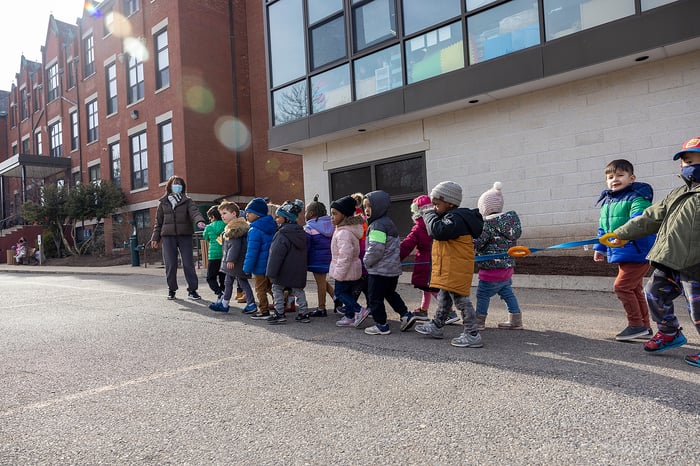Top 3 Administrators “Need to Knows” to Maximize Student Outcomes
Culture of Inclusion • 7 min read • Jul 12, 2021 3:31:42 PM • Written by: Dan Craddock

We are firm believers that while authentic inclusion may feel like a Sisyphean task, we can get there – and we will. That takes everyone in the school community doing their part. From special educators to classroom and specials teachers, after-school providers, and perhaps most importantly, administrators. Yes, You! Probably not that big of a surprise, but leaders are the lynchpin to living the vision of inclusion.
We know you’re in charge of a lot, so we put together this list of the 3 most important things you need to know to ensure that students with disabilities are supported in your school. Hint, hint…you’re going to want to bookmark this link.
Here goes.
#1: Compliance is not the end goal.
We know compliance with federal IDEA mandates is important (e.g., annual reviews by the deadline, including parents in the process, documenting key processes) – it ensures student rights are being met and enables processes that serve students who need extra support. However, research shows that compliance may not have the impact on student outcomes that we’d think!

Schools are required to provide a “free and appropriate public education” (also known as FAPE) to students with disabilities who require special education to make progress memorialized in an individualized education program (IEP). Services and instruction must be “specially designed” to meet a child’s unique needs.” Technically, FAPE = compliance, but high-quality instruction is also so much more. Access to high-quality instruction for all students is EQUITY.
Here are a few pointers for putting this into practice:
- The IEP cannot repeat the same goals over and over again with no progress;
- Students have to be educated with their non-disabled peers to the maximum extent possible;
- Families have to be engaged and included as contributing members of the IEP team; and
- Instruction must be individualized & specialized to remove barriers to learning and progress for each student.

#2: Not all special education decisions should be delegated.
While it is true that special educators have unique training and skillset, it is still essential that school leaders have a basic understanding of how special education works in order to make equitable decisions that support all learners.
Special education is more than just “good education.” In inclusive settings, special education requires careful tailoring between what a student needs and the services & supports they receive at school. Those needs may or may not be defined by their disability! Educators need the skills and training to determine the difference.
To make informed decisions, we recommend that administrators have a basic understanding of the special education process and how inclusive settings can help all learners. Some administrator-centric tips:
- Identify some key performance indicators that align with the school’s instructional vision. Review progress to goals on a regular basis! This could be a fun way to include the students to get them excited about achieving goals.
- Include a special education leader on your leadership team and encourage them to be active participants in planning conversations.
- Understand how your budget decisions have downstream impacts on resource allocation for special education programming. Don’t allow students to be left behind due to poor planning.
- Master your master schedule to ensure students are the driving force behind decisions (e.g., enable educators to co-plan if they share students).
- Ground decisions in the foundational question – “How will this impact my most diverse learners?”

#3: Meeting the needs of your most diverse learners can help all students succeed.
This is the core principle that we live by. It’s no longer ok to operate with a lens that educating students with disabilities is separate work. Inclusive education demands more!
Recent research has demonstrated that children with disabilities can achieve the same, if not more, growth than their non-disabled peers in the same amount of time under similar circumstances. One study reports that up to 90% of SWDs with high-incidence disabilities should be performing at the same levels as their non-disabled peers.
So why is it so hard to get there? That’s a blog (or a book…or an anthology) for another day, but some root causes include:
- Lack of efficient data systems that make using data easy;
- Lack of tools and processes for targeted collaboration;
- Lack of knowledge by all educators about the impact of disability and learning; and
- And on and on.
And COVID certainly didn’t make our work easier.

The root causes require intentional disruption and likely, years of re-working to ensure that all children have access to great content. But there are certainly places leaders can start. For example, we know that pairing students with educators who embrace a growth mindset can lead to changes in young people’s brains and high-quality instruction can impact the learning trajectory for some of the hardest to serve students.
Let’s keep fighting the good fight! Fight for the inclusion of all students for the betterment of all students, those with and without disabilities. It works…and it’s most certainly worth it.
Ready to Make an Impact For Your Most Diverse Learners?
Dan Craddock
Our Latest
Related Articles

June 17, 2024 | Administrators
Decoding the Difference: What Administrators Need to Know about MTSS vs. Special Education
Learn the distinctions between MTSS and special education frameworks, and expert strategies for scho...

April 9, 2021 | Tools
8 Ways to Elevate Your Specially Designed Instruction Skills for Hybrid Settings
Understanding Specially Designed Instruction in Special Education: Delve into the IDEA-defined appro...

June 9, 2023 | Culture of Inclusion
The Underrated Strategy of Pre-Teaching – And Why Offering Teachers Training At the End of the Year Makes Sense
Discover the effective pre-teaching strategy for diverse students based on IEP training for teachers...
